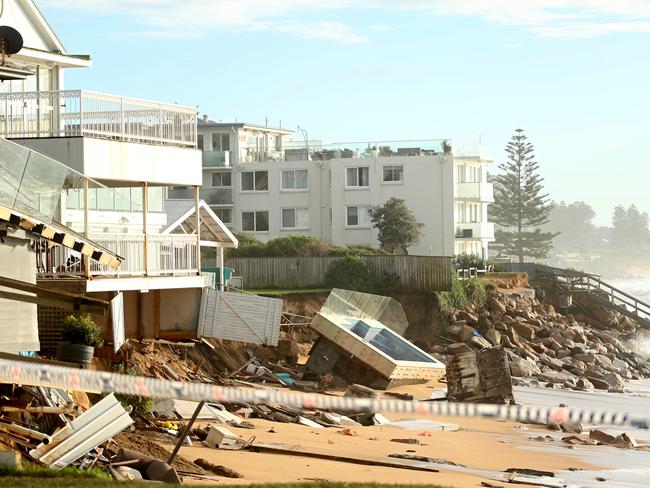Who approved the pool in Collaroy?
A CONCRETE pool that collapsed on Collaroy beach was designed to weather a one-in-100-year storm — but should it have been built?
IMAGES of a concrete pool lying discarded on Collaroy Beach have been beamed around the world, a powerful symbol of the ocean’s destructive capability.
But as the sea recedes and the clean-up begins, some may wonder whether it was such a great idea to build a pool in an area known for being at the mercy of severe storms and coastal erosion.
The pool, which did not break, has been hailed by some as an engineering success.
But it could easily have become a hazard if it had smashed into another structure, something Warringah Council recognised when it approved the plans in 2014.
“As the pool is to be located within the area of wave impact it is likely to be damaged during a coastal storm,” a report from the council’s natural environment unit said.
“This would create a hazard for the property at 1142 Pittwater Rd, adjoining properties and the beach,” it said.
In order to address this, the unit recommended that the pool plans include conditions to ensure it was “suitably designed”.
Warringah (now amalgamated into Northern Beaches Council) did include a condition for the pool be designed and constructed to “withstand the impacts of coastal erosion and wave impact resulting from a one in 100 year ARI (Average Recurrence Interval) event”.
The engineer who designed the pool, Savvas Polycarpou, said he met this criteria and pointed out that the walls of the pool did not break.
“It moved in one piece, it didn’t break,” he said.
He said it would be impossible to design against the erosion of sand, as this would have involved constructing a retaining wall and bringing in rocks, something he was not instructed to do.
“A sea wall is a matter for the council to decide,” he said.

The broader issue of whether it was actually a good idea to allow a pool to be built in the area, doesn’t seem to have been considered by council.
In the council’s pool assessment and approval, there was no mention of the need for a seawall in the area, which council has tried to build in the past and recognised is needed. Without a seawall the beach is particularly vulnerable to erosion in a storm and this makes it likely any pool built could be dislodged.
For Mr Polycarpou, he believes his pool design did what it was meant to.
“The walls didn’t break but I couldn’t design against the forces of a 10m wave,” he said.
Whether or not Mr Polycarpou satisfied the council’s requirements was not something the council ever assessed, because the final design was not approved by them, it was approved by a private certifier.
In its approval, the council stated that details demonstrating compliance with the one-in-100-year requirement must be prepared by a “suitably qualified engineer” and submitted to the “certifying authority” for approval prior to the issue of the construction certificate.
“Council had no role in relation to the certification,” a council spokeswoman told news.com.au.
The person who gave the final tick-off to the pool was private certifier Dom Di Matteo of DM Certifiers Pty Ltd.
Mr Di Matteo told news.com.au certification from an engineer confirming the pool could withstand a one-in-100-year storm was received, and this had been lodged with council. He did not provide a copy of this document and news.com.au could not find a copy online.
News.com.au asked council whether it thought the pool did meet the one-in-100-year requirement, but a spokeswoman said it had not yet been determined whether the recent storm was such an event.
When asked if council set any criteria, such as flood levels or other impacts that the pool would be expected to survive to satisfy the one-in-100-year requirement, the spokeswoman said the pool went through a private certifier and the council did not wish to add any further comments.
Council would also not say whether it would allow the pool to be reinstalled.
There is one last catch.
The builder involved in the pool, who did not wish to be named, said private certifiers generally relied on engineers to meet design requirements. A certifier’s job generally involves checking that the building complies with the designs provided.
So it’s really up to the engineer to meet the requirements, and it seems that could be a matter of interpretation.
News.com.au has reached out to the owner of the pool.



